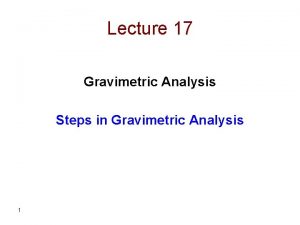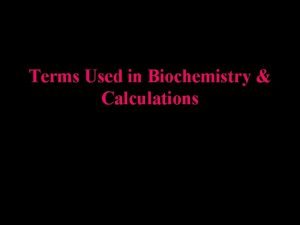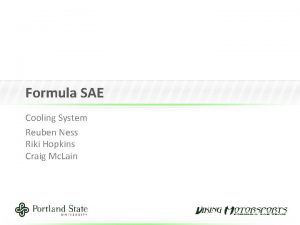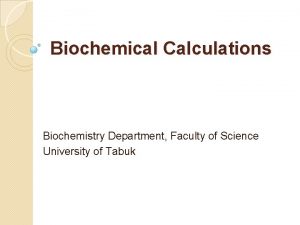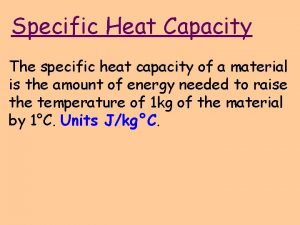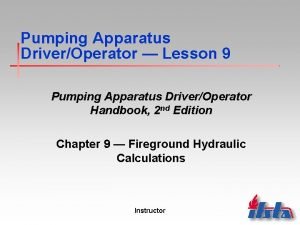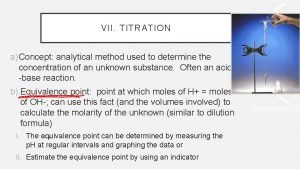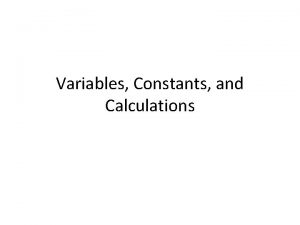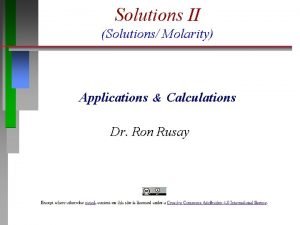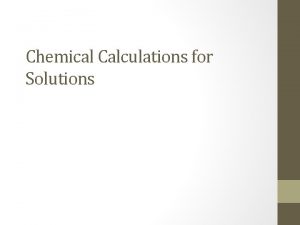p H Calculations in Solutions p H Calculations








- Slides: 8

p. H Calculations in Solutions p. H Calculations in Acidic Solutions Calculations are shown some differantions related to acids strength. Ka (a constant for acids ionization) values are related to acids strength. Ka = 0 – 10 -2 are strong acids. Ka = 10 -2 – 10 -8 are weak acids. Ka < 10 -8 are very weak acids. Monoprotic acids are release only one proton to media. This acids divided to strong, weak and very weak acids. Strong monoprotic acids are ionized % 100. HCl, HNO 3 and H 2 SO 4 are strong monoprotic acids. If the concentration of strong acids are higher than 10 -6 M. In these calculations, H+ from water ionization should be omitted. Then, For calculations of p. H, - log of [H+] are calculated.

If the concentration of strong acids are lesser than 10 -6 M, H+ from water ionization should not be omitted and add to calculations. In this type of calculation, mass balance and charge balance terms should be used. Mass balance is; the total mass of decomposition of compounds is equal to mass of a compound before decomposition. Charge balance is; in solutions, positive charge compounds concentration is equal to negative charge compounds concentration. In HCl; HCl → H+ + Cl- Water ionization is important in there. H 2 O �H+ + OHFor calculations of HCl solutions p. H (Concentration is lesser than 10 -6) Charge balance is; [H+] = [Cl-] + [OH-] C (acids concentration) = [H+] = [Cl-] [H+] = [C] + [OH-] In these eqautions, we could be write [OH-] from KW

Weak monoprotic acids: These types of acids are ionizable in water with a significant % but not % 100. CH 3 COOH and HCOOH are example to weak monoprotic acids. The ionization balances of these acids are used for calculations of their p. H. For example for CH 3 COOH, CH 3 COOH �CH 3 COO – + H+ C–x x x [H+] should be omitted near C. Because, ionizable amounts of started concentrations are lower than started concentrations of acids. So the formula is;

Ionization are related with p. H of media. In this condition, rate of ionization (α) are calculated as; Very weak monoprotic acids: These acids Ka values are lower than 10 -8 M. For this reason, it hasn’t any strong proton that titratable in water media. But, it will be titratable with some strengthening compound. H 3 BO 3 and HCN are examples to these acids. For calculation of p. H, H+ from water has not omitted. HA + H 2 O �H 3 O+ + AH 2 O �H+ + OHCharge Balance: [H 3 O+] + [H+] = [OH-]

p. H Calculations in Base Solutions Calculations are shown some differentials related to bases strength. Kb (a constant for bases ionization) values are related to bases strength. Kb = 0 – 10 -2 are strong bases. Kb = 10 -2 – 10 -8 are weak bases. Kb < 10 -8 are very weak bases. Monohyroxide bases Monohydroxide bases are release only one hydroxide to media

Strong Monohydroxide bases Strong monohydroxide bases are ionized % 100. Na. OH and KOH are exampled to strong monohydroxide bases. If the concentration of strong bases are higher than 10 -6 M, In these calculations, OH- from water ionization should be omitted. Then, For calculations of p. OH, - log of [OH-] are calculated. If the concentration of strong bases are lower than 10 -6 M, in these calculations, OH- from water ionization should not be omited and add to calculations. In this type of calculation, mass balance and charge balance terms should be used. For Na. OH; Mass balance is; C (base concentration) = [OH-] = [Na+] Charge balance is; [Na+] + [H+] = [OH-]

For calculations of Na. OH solutions p. OH (Concentration is lesser than 10 -6) Charge balance is; [OH-] = [Na+] + [H+] C (base concentration) = [Na+] = [OH-] = [Na+] + [H+] In these equations, we could be write [OH-] from KW Weak monohydroxide bases: These types of bases are ionizable in water with a significant % but not % 100. NH 4 OH are example to weak monohydroxide bases. The ionization balances of these bases are used for calculations of their p. H.

Weak monohydroxide bases: These types of bases are ionizable in water with a significant % but not % 100. NH 4 OH are example to weak monohydroxide bases. The ionization balances of these bases are used for calculations of their p. H. For NH 4 OH; NH 4 OH �[NH 4+] + [OH-] C-x x x

